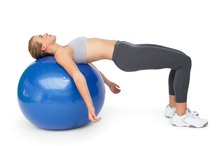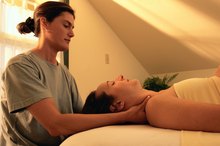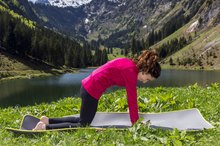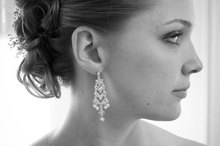Exercises for Cervical Facet Joint Pain
The facet joints in the spine help you to move and twist. The cervical spine facet joints are located in the back and side of the neck. When you injure this area -- such as after experiencing whiplash -- you may feel pain not only in the neck, but also in the shoulders and arms. In addition to taking anti-inflammatory medications and using treatments like heat wraps to relieve cervical facet joint pain, you also can engage in regular stretching exercises to relieve muscle tension.
Neck Rotation
The neck rotation stretch is especially effective in relieving cervical facet joint pain because it encourages range of motion in the neck. To perform, look straight ahead, then turn your head to your left side, stretching as far as you can to this side without pain. Focus on a target on the wall that can help you maintain the stretch for 20 seconds. Release the stretch, then repeat on this side for three times, trying to stretch a little further with each repetition. Turn to the right side to repeat the activity.
- The neck rotation stretch is especially effective in relieving cervical facet joint pain because it encourages range of motion in the neck.
- Focus on a target on the wall that can help you maintain the stretch for 20 seconds.
Forward/Backward Bending
McKenzie Exercises for the Neck
Learn More
When you have difficulty moving the neck, the ability to perform movements like nodding your head can be difficult. Backward and forward bending can help to relieve this neck muscle tension. Begin in a seated position, keeping your back straight and your focus forward. Pull the chin down toward the chest, feeling a stretch in the back of the head. Hold this position for five seconds, then look up toward the ceiling. Hold this position for five seconds, then repeat the exercise five times.
- When you have difficulty moving the neck, the ability to perform movements like nodding your head can be difficult.
SCM Stretch
The sternocleidomastoid, or SCM, muscle connects the base of the head and jaw to the clavicle bone. If you experience cervical facet joint pain, particularly on the side of the neck, this stretch can help. Begin by leaning your head over, pretending you are trying to touch your left ear to your left shoulder. Now turn the chin up slightly toward the ceiling. You should feel a stretch in the side and front of the neck. Hold this position for 20 seconds, then release the stretch. Repeat on this side for two to three times, then switch to the opposite side.
- The sternocleidomastoid, or SCM, muscle connects the base of the head and jaw to the clavicle bone.
- If you experience cervical facet joint pain, particularly on the side of the neck, this stretch can help.
Trapz Stretch
Clavicle Stretches
Learn More
The trapz stretch stretches the trapezius muscle, which rests at the base of the neck. Start by leaning your head to the right, bringing your right ear toward your right shoulder. Now move the chin toward your chest, feeling a pull in the shoulder and back of the neck. Hold this position for 20 seconds, then release the stretch and raise your head. Repeat the stretch on this side for two to three repetitions, then switch to stretch to the opposite side.
- The trapz stretch stretches the trapezius muscle, which rests at the base of the neck.
- Now move the chin toward your chest, feeling a pull in the shoulder and back of the neck.
Related Articles
References
- Sports Injury Clinic: Whiplash
- Net Doctor: Whiplash
- The University of Queensland: Whiplash Injury Recovery
- Spine-Health; Treatment Options for Facet Joint Pain; Dr. Charles Ray; December 2002
- The Pain Clinic: Simple Neck Pain
- Lurati AR. Health issues and injury risks associated with prolonged sitting and sedentary lifestyles. Workplace Health Saf. 2018;66(6):285-290. doi:10.1177/2165079917737558
- Nakphet N, Chaikumarn M, Janwantanakul P. Effect of different types of rest-break interventions on neck and shoulder muscle activity, perceived discomfort and productivity in symptomatic VDU operators: A randomized controlled trial. Int J Occup Saf Ergon. 2014;20(2):339-53. doi:10.1080/10803548.2014.11077048
- Cooley D, Pedersen S. A pilot study of increasing nonpurposeful movement breaks at work as a means of reducing prolonged sitting. J Environ Public Health. 2013;2013:128376. doi:10.1155/2013/128376
- Daneshmandi H, Choobineh A, Ghaem H, Karimi M. Adverse effects of prolonged sitting behavior on the general health of office workers. J Lifestyle Med. 2017;7(2):69-75. doi:10.15280/jlm.2017.7.2.69
- Henning RA, Jacques P, Kissel GV, Sullivan AB, Alteras-Webb SM. Frequent short rest breaks from computer work: Effects on productivity and well-being at two field sites. Ergonomics. 1997;40(1):78-91. doi:10.1080/001401397188396
- Ylinen J, Kautiainen H, Wirén K, Häkkinen A. Stretching exercises vs manual therapy in treatment of chronic neck pain: A randomized, controlled cross-over trial. J Rehabil Med. 2007;39(2):126-32. doi:10.2340/16501977-0015
Writer Bio
Rachel Nall began writing in 2003. She is a former managing editor for custom health publications, including physician journals. She has written for The Associated Press and "Jezebel," "Charleston," "Chatter" and "Reach" magazines. Nall is currently pursuing her Bachelor of Science in Nursing at the University of Tennessee.









